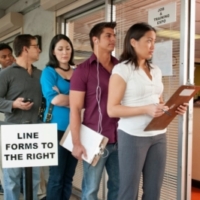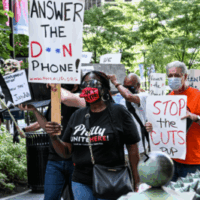On March 12, 2020, the U.S. Department of Labor issued a guidance clarifying what measures states can take to improve access to unemployment insurance (UI) for workers who lose their jobs or are temporarily separated from work due to the coronavirus. Below is a summary of the most helpful state provisions adopted as of March 27, 2020.
NELP also has published a set of recommendations for state reform and summaries of the UI provisions in the Coronavirus Aid, Relief, and Economic Security (CARES) Act and the Families First Coronavirus Response Act, which incentivizes states to adopt certain baseline reforms, such as waiving the waiting-week and work-search requirements that limit access to UI.
States are moving quickly to adopt changes, so we caution that this document may not be comprehensive, although we will update it regularly. Please contact Maurice Emsellem (emsellem@nelp.org) or Paul Sonn (psonn@nelp.org) if you have information about additional state actions taken to expand unemployment benefits in response to the pandemic.
States Have Adopted a Range of Helpful Policies to Expand Access to UI benefits
- At least 35 states have taken action (either legislatively, by executive order, or by administrative authority) to waive the one-week waiting period that all but seven states (GA, IA, MD, MI, NV, NJ, VT, WY) impose for most workers to collect UI benefits.
- At least 16 states have indicated that benefits issued will not be “charged” to the employer’s “experience rating”—meaning that employers will not be penalized with higher UI tax rates in future years because of pandemic-related layoffs. This is important to ensure employers do not try and discourage employees from filing claims.
- By executive order, Michigan and Georgia have extended their states’ benefits to provide 26 weeks of UI (rather than the 20 and 14 weeks of benefits those states typically provide).
- At least 27 states have waived requirements that workers actively search for work. Several states, including Massachusetts and Washington, have adopted emergency regulations that clarify workers’ right to collect UI while in unpaid “standby” status and awaiting a determination from their employers as to when to return to work.
- Several states (including California, Washington, and New Jersey) have developed especially well-designed outreach material, flyers, and FAQs communicating, in clear and simple terms, workers’ rights to access UI and other benefits in response to COVID-19. Several states have provided more detailed technical filing instructions for COVID-19 claimants or have developed clear video guides showing claimants how to file.
- Kentucky (through legislative action) and New Hampshire (through executive order) expanded their state UI programs to cover workers who are not traditionally eligible for UI, such as bona fide independent contractors and self-employed individuals.
- Several states, including Kentucky and Washington, took major legislative action to strengthen their UI programs. Kentucky extended eligibility to workers reduced to part-time hours and modernized its method for calculating benefit levels through an alternative base period. Washington State extended access to its work-sharing program for reasons related to COVID-19.
- Several states (e.g., New York, Michigan, Illinois, Maryland, and Colorado) are attempting to address unprecedented demand on their servers by setting a filing schedule with claimants assigned to a specific filing day. It is not clear, however, that these measures are sufficient to address the overwhelming demand on state servers. States such as New York, California, and Kentucky are expanding staffing to meet the claims-processing demand through new hiring or redirecting staff from other agencies.
Download the full brief for detailed table of state policy changes.
Related to
Related Resources
All resourcesCase Study: How Virginia Worker Advocates Advanced Unemployment Insurance Reform in a Divided State Government

Policy & Data Brief
Letter on Making Reforms to Virginia’s Unemployment Insurance System

Comments & Letters
Letter on Rescinding Funds for Improving Unemployment Insurance Systems

Comments & Letters

